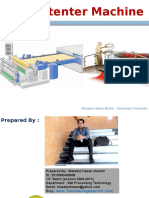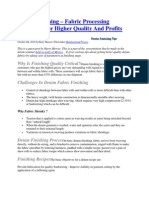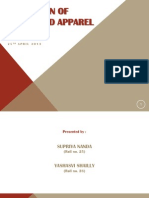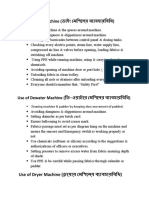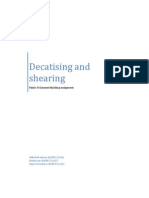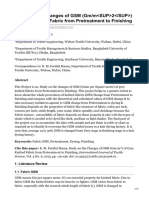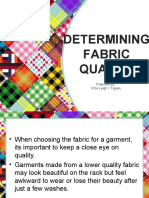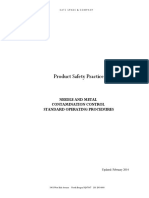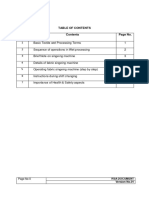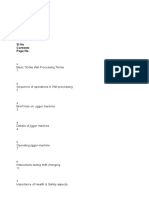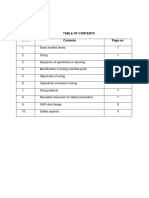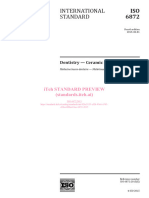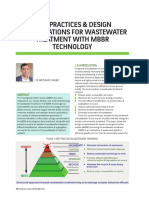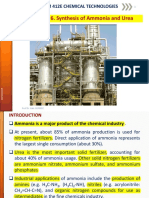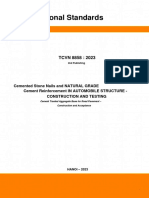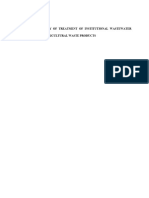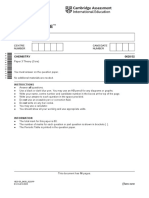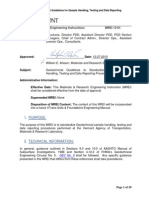Stenter Machine
Stenter Machine
Uploaded by
s hassCopyright:
Available Formats
Stenter Machine
Stenter Machine
Uploaded by
s hassOriginal Description:
Copyright
Available Formats
Share this document
Did you find this document useful?
Is this content inappropriate?
Copyright:
Available Formats
Stenter Machine
Stenter Machine
Uploaded by
s hassCopyright:
Available Formats
TABLE OF CONTENTS
SI No Contents Page No.
1 Basic wet Processing Terms 2
2 Sequence of operations in Wet processing 3
3 Brief Note on Stenter machine 4
4 Details of stenter machine 4
5 Operating stenter machine 7
6 Instructions during shift changing 12
7 Importance of Health & Safety aspects 13
Page No 0 RSA DOCUMENT
Version No.01
1. BASIC WET PROCESSING TERMS:
ABSORBENCY: The ability of one material to take up another material.
BLEACHING: It is a process to remove the natural and artificial impurities i n fabrics
to obtain clear white for finished fabric or in preparation for dyeing and finishing.
CHEESE: A cylindrical package of yarn wound on a flangeless tube.
DENSITY: The mass per unit volume
DYEING: It is a process of coloring fibers, yarns, or fabrics with either natural or
synthetic dyes.
DYES: Substances that add color to textiles.
EFFLUENT: Waste water released after pretreatment, dyeing & finishing of Textile.
FINISHING: It includes various operations such as heat-setting, napping,
embossing, pressing, calendaring, and the application of chemicals that change the
character of the fabric.
LUSTER: The quality of shining with reflected light on textile material.
pH: Value indicating the acidity or alkalinity of a material.
PIGMENT: An insoluble, finely divided substance, used to color fibers, yarns, or
fabrics.
SOFTENER: A product designed to impart soft mellowness to the fabric.
YARN: A generic term for a continuous strand of textile fibers, filaments, or material
in a form suitable for knitting, weaving, or otherwise intertwining to form a textile
fabric.
YARN COUNT: Yarn count is the numerical expression of yarn, which defines its
fineness or coarseness. (Linear density).
Page No 1 RSA DOCUMENT
Version No.01
2. SEQUENCE OF OPERATIONS IN WET PROCESSING
ENTRY OF GREY FABRIC
SINGEING & DESIZING
SCOURING & BLEACHING
MERCERIZATION
DYEIING PRINTING
POST DYEING/PRINTING PROCESSES
(CURING/STEAMING/FIXING/WASHING/DRYING)
FINISHING
BRUSHING / RAISING/ CALENDERING
SANFORIZATION OR ZERO ZERO
FINAL INSPECTION
PACKING
Page No 2 RSA DOCUMENT
Version No.01
3. Brief note about Stenter:
Stenter machine:
A Stenter is a fabric transport device for bringing dimensional stability to the
fabric. This machine grasps fabric at both selvages simultaneously and continuously
and carries it from one point to another. Two endless chains equipped with either
clips or pins grasp the selvages and move in a proper way, carrying the fabric
between them. The width between the two chains can be automatically adjusted by
means of motor arrangements. A stenter is the best method of handling fabrics that
require precise width control.
The following activities are carried out in stenter machine:
1. Application of finishing chemicals.
2. Drying and stretching
3. Curing
4. Heat setting
5. Pigment dyeing
4. Details of stenter machine:
Inlet J-scray: This part is used to store the fabric during the batch change and Inlet
unit contains various parts like tension device, draw roll, pressure roll and break roll.
The important functions of the above rollers are to feed the fabric evenly throughout
the machine.
Padding mangle: It contains chemical trough, guide rollers and squeezing mangle.
Fabric is dipped into the finish chemical then sent to squeezing mangle. During this
time finish chemicals are applied on the fabric and squeezes out extra chemicals
from the fabric.
Mahlo device (weft straightener): It has two bow and three skew rollers which
correct the skewness and bowing and make the weft yarns straight.
Page No 3 RSA DOCUMENT
Version No.01
Over feed system: To give over feed or under feed of the fabric to respective chain
track.
Inlet chain track: To aid proper pinning or clipping of the fabric.
Inlet chain track Over feeding system
Drying chambers: To dry the fabric or to fix the finishing chemicals by hot air from
the blowers. The blower sucks hot air from radiator and blow it into the nozzles
through which drying occurs. Inside the drying chamber also contains width
adjustment spindle and pin/clip chain track.
There are 8-10 drying chambers in stenter machine, each having 3 meter in
length.
Inlet feeding unit functioning of drying chambers
Page No 4 RSA DOCUMENT
Version No.01
Padding mangle weft straighter
Pins & clip arrangement
De-clipping zone
Clip and pin together Cleaning of clip and pin
Outlet chain track: To facilitate de-pinning or De-clipping of fabric from pins/clips.
And to give proper cleaning of the pins & clips.
Batching and plaiting unit: To wind the fabric on A-frame or plaiting of finished
fabric in a suitable box/ trolley.
Fabric requirements for finishing:
ABSORBENCY: 5-6 Seconds
pH of the fabric : 5.5 to 7
Temperature : 40ºC or below
Page No 5 RSA DOCUMENT
Version No.01
Various finishes and their importance:
Soft finish: This finish gives softness, good luster as well as smoothness to fabric.
Resin finish (Crease resistance): This reduces wrinkling tendency of cotton textiles
as well as blends and avoids the necessity of ironing.
Anti-microbial, dust mite finish: This finish inhibits growth of microbes that causes
unpleasant odour & helps textiles to maintain hygienity.
Stain release/soil release finish: This is a easy care finish which induces easy
removal of soil & stains from the fabric during washing.
General guideline for temperature setting in drying
chamber No- 1-8 (°C)
FINISH TYPE
1 2 3 4 5 6 7 8
SOFT FINISH 110 120 130 140 140 140 140 140
RESIN FINISH 110 130 150 160 160 160 160 160
WATER
110 130 170 180 180 180 180 180
REPELLENT
AROMA FINISH 100 110 120 120 120 120 120 120
Page No 6 RSA DOCUMENT
Version No.01
5. Operating stenter machine:
Switch ON the main on panel Open the steam, water and air valve
Find out the right batch for finish placing the batch in the machine
Page No 7 RSA DOCUMENT
Version No.01
Weighing of required chemicals filtering the chemical
Proper feeding of fabric in chain track
Page No 8 RSA DOCUMENT
Version No.01
Setting parameters in panel board Inspecting of fabric final stage
Adjusting the machine settings checking the width and other defects
Page No 9 RSA DOCUMENT
Version No.01
Understand and follow the instructions from lot card and programme book.
Switch ON main power and then open compressed air, water valve and
thermic oil circulation.
Check the quality and lot number of the fabric before putting on the machine
by checking the label.
Transport the dyed or printed fabric to be run, to the inlet feeding unit of
stenter machine using hydraulic hand puller or electric truck.
Stitch the two ends; one end is fabric to be finished and the other is the leader
fabric in the machine.
After stitching ensure the straightness of fabric without crease
Ensure the required finish chemicals to be ready before starting stenter
machine.
Do chemical preparation in front of the shift in charge.
Observe the defect in the fabric before and during the process and report to
the supervisor if any irregularities observed.
Adjust machine parts according to the parameters,
Set the Speed of the machine according to instructions of supervisor (For
normal finishing operation 80-100 m/min (meters per min), heat-setting,
curing and other special finishes 15-50 m/min.)
Check & ensure the level of finishing chemicals in padding mangle(normally
85%) and squeezing mangle pressure are set according to finishing type.
Most of the finishing operation requires 65-85% of chemical pick-up.
Keep Weft straightener (Mahlo) in ON and check visually the warp and weft
pattern in the fabric are straight.
Page No 10 RSA DOCUMENT
Version No.01
Set over feed of the fabric in % (for mercerized qualities it may be set 0-4%
and for unmercerised it can be 6-10 %.)
Do not allow any selvedge folds or improper pinning/ clipping in the inlet chain
track.
Set the drying chamber temperature/blower fan speed based on finish
required.
Now check initially the width of each lot and set accordingly final required
width, gradually increase in each chamber.
In last chamber keep width 1 inch or (as per supervisor’s instructions) more
than the required width.
Maintain required moisture content in finished fabric.
Check for various process damages in the finished fabric like stains – dust,
chemicals, rust, handling stains, crease, water dropping, oil, grease, etc.
Cleaning in Stenter machine
Remove regularly accumulated dust and dirt from the machine.
Clean all the rollers with the dry fabric.
Clean the Drying chamber filter in every shift.
Clean the Stenter inlet sensors and fabric guides properly.
Clean all the pin/clips once in a day (or as specified by the supervisor) for
effective width adjustment.
Collect the waste from all cleaning activities and store at designated place .
Page No 11 RSA DOCUMENT
Version No.01
6. INSTRUCTIONS DURING SHIFT CHANGE OVER:
Taking charge of duties while starting of shift:
Come at least 10 - 15 minutes earlier to the work place.
Meet the previous shift operator and discuss regarding the issues faced by
them with respect to the quality or production or spare or safety or any other
specific instruction etc.
Uunderstand the fabric being processed & process running on the machine .
Ensure technical details are mentioned on the job card & display in machine.
Check the next batch fabric to be processed is ready near the machine.
Check the cleanliness of the machines & other work areas.
Question the previous shift operator for any deviation in the above and bring
the same to the knowledge of the shift superior.
Handing over charge at the end of shift:
Properly hand over the shift to the incoming operator.
Provide all the details regarding Fabric quality & the process running on the
machine.
Provide all relevant information regarding the stoppages or breakdown in the
machine, any damage to the material or machine.
Ensure the next lot to be processed is ready near the machine
Get clearance from the incoming counterpart before leaving the work spot .
Report to the shift supervisor in case the next shift operator do not report for
the shift.
Page No 12 RSA DOCUMENT
Version No.01
Report to the shift superior about the quality / production / safety issues/ any
other issues faced in the shift and leave the department only after getting
concurrence for the same from superiors.
Collect the wastes from waste bags, weigh them & transport to storage area.
7. Importance of Health and Safety:
Use and maintain personal protective equipment such as Hand Gloves, Gum
Boots, head cap etc., as specified.
Never handle chemicals with bare hands
Report any service malfunctions in the machine that cannot be rectified to the
supervisor.
Store materials and equipment at their designated places.
Minimize health and safety risks to self and others due to own actions .
Monitor the workplace and work processes for potential risks.
Do not carry any metallic parts during machine running as there are chances
of fire and damage to machine parts.
Take action based on instructions in the event of fire, emergencies or
accidents, participate in mock drills/ evacuation procedures organized at the
workplace as per organization procedures.
Page No 13 RSA DOCUMENT
Version No.01
You might also like
- 3.1 Clothing Performance Requirements - March 22Document60 pages3.1 Clothing Performance Requirements - March 22Rohan KabirNo ratings yet
- Astm A 780 - A 780M-09Document4 pagesAstm A 780 - A 780M-09Ramsi AnkziNo ratings yet
- Stenter Machine: Mazadul Hasan Shishir, Southeast UniversityDocument20 pagesStenter Machine: Mazadul Hasan Shishir, Southeast UniversitySyed Salahuddin MunnaNo ratings yet
- Modern Cotton Spinning Machinery, Its Principles and ConstructionFrom EverandModern Cotton Spinning Machinery, Its Principles and ConstructionNo ratings yet
- Compactor Machine & Sanforizing Machine: Presented ToDocument27 pagesCompactor Machine & Sanforizing Machine: Presented Tonasimul haqueNo ratings yet
- Benninger & Wet ProcessingDocument72 pagesBenninger & Wet ProcessingFary Sami100% (1)
- Assignment On An Overview of Quality and Quality Control in Textile IndustryDocument9 pagesAssignment On An Overview of Quality and Quality Control in Textile IndustryZAyedNo ratings yet
- Final Mill Tariniggng ReportDocument53 pagesFinal Mill Tariniggng ReportPriyanka VishnoiNo ratings yet
- Knitting Quality Control ProcedureDocument3 pagesKnitting Quality Control ProcedureJobaerNo ratings yet
- Wool 482 582 12 T 14 PDFDocument22 pagesWool 482 582 12 T 14 PDFRahman Trading CorporationNo ratings yet
- Stenter Machine Operator ManualDocument42 pagesStenter Machine Operator ManualGopuk KNo ratings yet
- On Textile TestingDocument17 pagesOn Textile TestingGourav Arora100% (2)
- Jigger Dyeing Machine:: Fabric PreparationDocument2 pagesJigger Dyeing Machine:: Fabric PreparationnaaomaiNo ratings yet
- Standard Operating Procedure For Pinch Setting, Snap Attachment & Performance TestingDocument16 pagesStandard Operating Procedure For Pinch Setting, Snap Attachment & Performance TestingMadawa MaduwanthaNo ratings yet
- Textile DocumentDocument28 pagesTextile DocumentKhandaker Sakib FarhadNo ratings yet
- Barre Causes and PreventionDocument19 pagesBarre Causes and PreventionReal SheriffNo ratings yet
- Fabric Inspection Training KDS FinalDocument78 pagesFabric Inspection Training KDS Finalprashantmithare100% (3)
- Cutting RoomDocument7 pagesCutting RoomAnkush PatidarNo ratings yet
- Denim FinishingDocument4 pagesDenim FinishingH. R. PatelNo ratings yet
- SOP Quality Control Process For Fabric Suppliers: PurposeDocument9 pagesSOP Quality Control Process For Fabric Suppliers: PurposesahilNo ratings yet
- Tinting or OverdyeingDocument4 pagesTinting or OverdyeingDelwar Hossain67% (3)
- Fabric Quality HandbookDocument51 pagesFabric Quality HandbookMorshed Mahamud100% (1)
- Fabric Inspection SystemDocument18 pagesFabric Inspection Systemইসলামিক টিভিNo ratings yet
- Fabric and Apparel TestingDocument42 pagesFabric and Apparel TestingSupriya NandaNo ratings yet
- Textile Testing & Quality ControlDocument12 pagesTextile Testing & Quality ControlAshikur Rahman100% (1)
- Business Lines: Agriculture Inspection Services Industry Inspection Services Marine - Offshore Inspection ServicesDocument28 pagesBusiness Lines: Agriculture Inspection Services Industry Inspection Services Marine - Offshore Inspection ServicesFrank SenanayakaNo ratings yet
- SOP For MCDocument5 pagesSOP For MCDyeing DyeingNo ratings yet
- ProcessingDocument24 pagesProcessingHumera khanNo ratings yet
- 4pt, 10pt SystemDocument12 pages4pt, 10pt SystemShaaban Noaman100% (1)
- Flammability Testing of Fabrics by Govardhana Rao ChilukotiDocument14 pagesFlammability Testing of Fabrics by Govardhana Rao ChilukotiVenkatesh BairabathinaNo ratings yet
- Definition of Garment WashingDocument45 pagesDefinition of Garment Washingrashad854100% (5)
- 23 Fabric Defects To Look Out For During Fabric InspectionDocument5 pages23 Fabric Defects To Look Out For During Fabric Inspectionudi969100% (2)
- Decatising and ShearingDocument8 pagesDecatising and ShearingOjasvi SrivastavaNo ratings yet
- Study On The Changes of GSM (GM/M 2) of Grey Knitted Fabric From Pretreatment To FinishingDocument19 pagesStudy On The Changes of GSM (GM/M 2) of Grey Knitted Fabric From Pretreatment To FinishingSamir RanaNo ratings yet
- Stone WashDocument3 pagesStone WashMuhammad MustahsinNo ratings yet
- StenterDocument2 pagesStenterMusa Eltayeb100% (2)
- Heat B SettingDocument18 pagesHeat B SettingharisNo ratings yet
- 36 Finishing Parameters and Controlling FactorsDocument48 pages36 Finishing Parameters and Controlling FactorsApar Singh100% (1)
- Pull Force Test of Buttons & AccessoriesDocument3 pagesPull Force Test of Buttons & AccessoriesjobaerNo ratings yet
- Quality Testing of The Terry Towel and Its Assurance MsDocument6 pagesQuality Testing of The Terry Towel and Its Assurance MsPankaj vermaNo ratings yet
- SCAP Session 10 Fabric LossesDocument21 pagesSCAP Session 10 Fabric LossesReena VermaNo ratings yet
- Spirality of Single Jersey Knitted FabricDocument13 pagesSpirality of Single Jersey Knitted FabricKazi Saiful IslamNo ratings yet
- Automatic Garment Spreading MachineDocument10 pagesAutomatic Garment Spreading MachineSadia WasimaNo ratings yet
- KQATEX1 Apparel Textile Requirements 150310Document17 pagesKQATEX1 Apparel Textile Requirements 150310Ammar Maqsood100% (1)
- SpiralityDocument9 pagesSpiralitySenthil KumarNo ratings yet
- In Line Inspection Report For Garments DivisionsDocument4 pagesIn Line Inspection Report For Garments DivisionsSayed Aasim JawaidNo ratings yet
- Classification & Yarn NumberingDocument21 pagesClassification & Yarn NumberingMewar Fashions100% (1)
- Cutting SOPDocument8 pagesCutting SOParvindtiwari21No ratings yet
- Determining Fabric Quality: Prepared By: Riza Leigh I. FiguesDocument55 pagesDetermining Fabric Quality: Prepared By: Riza Leigh I. FiguesRizaLeighFigues100% (1)
- Apparel Quality Management: Assignment Ii Total Quality Management Practices in Opex Group, BangladeshDocument11 pagesApparel Quality Management: Assignment Ii Total Quality Management Practices in Opex Group, BangladeshShivani JayanthNo ratings yet
- Apparel Materials Standards Manual 1Document61 pagesApparel Materials Standards Manual 1Fahad FarooqiNo ratings yet
- Fabric and Apparel Performance Testing ProtocolDocument20 pagesFabric and Apparel Performance Testing Protocolbeeyesyem100% (1)
- Needle and Metal Contamination Control PDFDocument18 pagesNeedle and Metal Contamination Control PDFMohammed IshakNo ratings yet
- Continuous BleachingDocument15 pagesContinuous BleachingTruin Clandes100% (2)
- Si No Page No.: Rsa Document Version No.01Document13 pagesSi No Page No.: Rsa Document Version No.01Grecella Marliyani SinagaNo ratings yet
- Si No Page No.: Rsa Document Version No.01Document15 pagesSi No Page No.: Rsa Document Version No.01Velmurugan ElumalaiNo ratings yet
- Si No Page No.: Basic Textile Wet Processing Terms 1Document23 pagesSi No Page No.: Basic Textile Wet Processing Terms 1BRANDONNo ratings yet
- WVG 9Document11 pagesWVG 9Ramasubramaniam PalaniswamyNo ratings yet
- Auto Coner Machine OperatorDocument15 pagesAuto Coner Machine Operatorzeeshan_2200% (1)
- Kaizen in Garment FactoryDocument16 pagesKaizen in Garment FactoryPhương DuyNo ratings yet
- Iso-6872-2015 Dental CeramicsDocument12 pagesIso-6872-2015 Dental CeramicsjonathanmarpsxNo ratings yet
- Material ScienceDocument3 pagesMaterial ScienceKrushnasamy SuramaniyanNo ratings yet
- Best Practices & Design Considerations For Wastewater Treatment With MBBR Technology.Document4 pagesBest Practices & Design Considerations For Wastewater Treatment With MBBR Technology.Ravishankar ANo ratings yet
- Notes Application: Metallographic Preparation of Nitrided and Nitrocarburised ComponentsDocument6 pagesNotes Application: Metallographic Preparation of Nitrided and Nitrocarburised ComponentsTanweer AlamNo ratings yet
- 6 Synthesis of Ammonia and UreaDocument25 pages6 Synthesis of Ammonia and Ureaeinmal04No ratings yet
- A-Level H2 Chemistry 01 Redox StoichiometryDocument35 pagesA-Level H2 Chemistry 01 Redox StoichiometryWilliam Yu Kai Wong50% (2)
- Preliminary EstimateDocument558 pagesPreliminary Estimatesurendra_pangaNo ratings yet
- (Eng. Version) Vietnam Road Spec TCVN 8858 2023Document33 pages(Eng. Version) Vietnam Road Spec TCVN 8858 2023sonhcqtgmail.comNo ratings yet
- Biological Oxygen Demand Test by APHADocument47 pagesBiological Oxygen Demand Test by APHAksbbsNo ratings yet
- Practice Problems in Timber Design PDFDocument9 pagesPractice Problems in Timber Design PDFRuby AsensiNo ratings yet
- Material Safety Ava ZR 5000Document4 pagesMaterial Safety Ava ZR 5000fs1640No ratings yet
- Bleach Fact Sheet Draft - Ejc2 - PDFDocument2 pagesBleach Fact Sheet Draft - Ejc2 - PDFWahyu Radityo UtomoNo ratings yet
- A Mini Project On Bituminous Road LayersDocument20 pagesA Mini Project On Bituminous Road Layersapi-1988935887% (39)
- Proposal On WastewaterDocument6 pagesProposal On WastewaterChukwu SolomonNo ratings yet
- CONSTANTS AND CALCULATIONS - Textile SpinningDocument8 pagesCONSTANTS AND CALCULATIONS - Textile SpinningLolla Ravi100% (16)
- Polymers Assignment SolutionDocument10 pagesPolymers Assignment Solutionjjsingh7986No ratings yet
- Acetic Acid CBSE Project Class 12Document18 pagesAcetic Acid CBSE Project Class 12Bhagat Singh RanaNo ratings yet
- ETABS Shear Wall DesignDocument2 pagesETABS Shear Wall DesignMihai CalinNo ratings yet
- Cambridge IGCSE: Chemistry 0620/32Document16 pagesCambridge IGCSE: Chemistry 0620/32RamY El NahasNo ratings yet
- FDM Nylon FamilyDocument6 pagesFDM Nylon FamilykaledioskoppNo ratings yet
- Oil Tempered WireDocument20 pagesOil Tempered WireGizem AkelNo ratings yet
- Waste Disposal RecordDocument8 pagesWaste Disposal RecordPawan Sharma100% (1)
- Procedure SandblastingDocument7 pagesProcedure SandblastingKusnadi -100% (2)
- MagneticMaterials1Document603 pagesMagneticMaterials1Adinda Van Den BergNo ratings yet
- MREI 12-01 Geotechnical Guidelines For Sample Handling, Testing and Data ReportingDocument20 pagesMREI 12-01 Geotechnical Guidelines For Sample Handling, Testing and Data ReportingJamie MooreNo ratings yet
- Catalogue PhomiDocument42 pagesCatalogue PhomiSulaiman SulaimanNo ratings yet
- Materials in Automotive Application, State of The Art and ProspectsDocument32 pagesMaterials in Automotive Application, State of The Art and ProspectsJasna GlisovicNo ratings yet
- MSDS - Mono Ethanol AmineDocument8 pagesMSDS - Mono Ethanol AmineExternal Relations DepartmentNo ratings yet
- Marco Xu PT 0 2: Cambridge IGCSEDocument32 pagesMarco Xu PT 0 2: Cambridge IGCSEXD derp02No ratings yet


